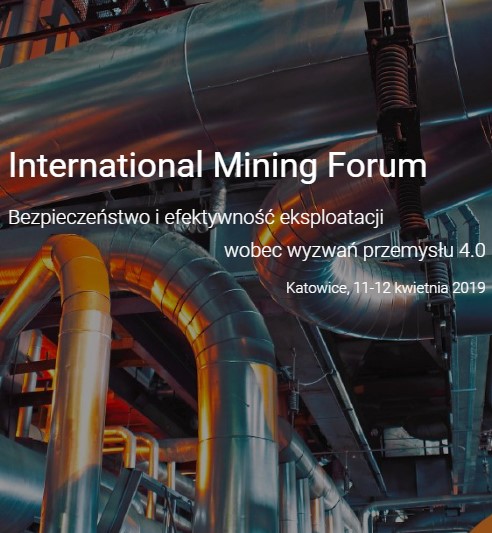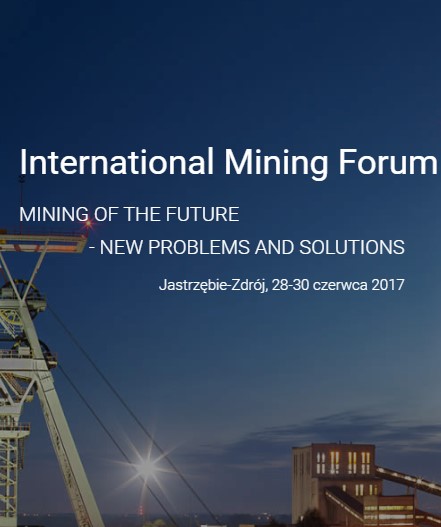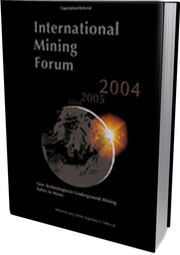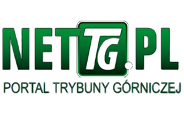Parameters of Injection Fill Above an Underground Gas Generator
Volodymyr I. Bondarenko, Volodymyr I. Buzylo,
Volodymyr S. Falshtynskiy, Roman O. Dychkovskiy
National Mining University. Dnipropetrovsk, Ukraine
ABSTRACT. Parameters of goaf filling by means of a solution injected through boreholes during underground gasification of coal are determined. Economic evaluation of the offered measures for the actual geological conditions of Western Donbass mines is given.
Advanced Experience and Direction of Mining of Thin Coal Seams in Ukraine
Volodymyr I. Bondarenko, Yuriy B. Griadushchiy,
Roman O. Dychkovskiy, Pavlo P. Korz, Olexandr I. Koval
National Mining University. Dnipropetrovsk, Ukraine
ABSTRACT: The authors described the technology and experience of mining thin and very thin coal seams in Ukraine. Geological conditions of Western Donbass mines allow mining coal to-gether with roof rocks. Such technological changes were approved for “Geroiv Kosmosu” mine PC “Pavlogradvugillia”.
KEYWORDS: Thin and very thin coal seams, auger coal mining, underground gasification, me-chanized mining sets
Research of Rock Stresses and Deformations Around Mining Workings
Volodymyr I. Bondarenko, Gennadiy A. Simanovich, Iryna A. Kovalevska
Vadym V. Fomichov, Volodymyr P. Serdiuk
National Mining University. Dnipropetrovsk, Ukraine
ABSTRACT: Research of geomechanics of stratified and the stress conditions of rock in vicinity of mining workings are conducted. Distributions of stresses in various mining conditions are ana-lysed.
Limits to Economic Viability of Extraction of Thin Coal Seams in Ukraine
Gennadij G. Piwniak, Volodymyr I. Bondarenko, Volodymyr I. Salli,
Iryna I. Pavlenko, Roman O. Dychkovskiy
National Mining University. Dnipropetrovsk, Ukraine
ABSTRACT: The Ukrainian coal industry extracts coal seams in thickness range from 0.8 m. Seams thinner than 1.5 m account for 90% of the coal reserves. The fuel situation in the country demands de-veloping an effective mechanism for delimiting economic feasibility of coal extraction. With this purpose in mind an effective and simple method based on an economic reliability parameter was de-veloped at the National Mining University. It analyses the technical, technological, economic and geo-logical condition of a specific mine. According to its value mines are divided according to their sus-ceptibility to injections of capital.
On the Present Situation and the Future Development of the Thin Coal Seam Working Technology and Equipment
Meng Xiangrui, Yuan Shujie, Zhao Guangming
Dept. of Resources Exploration and Management Engineering,
Anhui University of Science and Technology. Huainan 232001, China
ABSTRACT: The present paper starts with an introduction of the present situation concerned with the thin coal seam working technology and the mechanized working method at home and abroad. In the introduction, the focus is laid on the present situation in China concerned with the machinery for the working of the thin and extremely thin coal seams. Specifically speaking, the characteristics of such coal working machines as coal winners, coal planers, rotary buckets and others are discussed with a presentation of the problems with these machines. Compared with those used abroad, a dis-cussion is presented about the shortcomings of the thin coal seam working technology and equip-ment in China with the future development and trends in this aspect discussed.
KEYWORDS: Thin coal seam mechanization, rotary bucket, coal planer
The Practical Experience from Mining the 385/2 Coal Seam with Thickness Below 2.0 Metres at Lubelski Węgiel
“Bogdanka” S.A. Coal Mine
Janusz Chmielewski, Bolesław Kozek
Lubelski Węgiel “Bogdanka” S.A. at Bogdanka
ABSTRACT: The paper describes the mining and geologic conditions and the two mechanized long-wall equipment sets used when mining the 385/2 coal seam, with thickness in the area of interest of between 1.6 to 2.0 metres, at “Bogdanka” mine. The seam has been under extraction in area V since 1997 and the sixth longwall has recently been started up there, and in area IV, where the first long-wall started in 2005. Both longwalls are equipped with Glinik mechanized supports and Joy shearers. The paper presents the production results close to 10,000 MT of coal per day achieved in area V and even more from the first longwall in area IV. The advance achieved by the longwall in March 2006 was 407 metres with an average daily output of 15,000 MT of coal. Another interesting mi-ning experiment was, described in the paper, controlled stoppage of the longwall for over one month in July 2006.
KEYWORDS: Underground mining, hard coal, Lubelskie Zagłębie Węglowe, thin deposit mining, concentration of output
Experiences with Fibre Bragg Gratings for Measuring Blast Induced Vibrations on Buildings
Carlsten Drebenstedt*, Steffen Paessler
Technical University Bergakademie Freiberg, Institute of Mining. Freiberg, Germany
ABSTRACT: In the present paper, the application of a fibre-optic system to determine and evalu-ate the effects of blast-induced vibrations on buildings is discussed. For the first time in quarrying, so-called fibre bragg gratings were used to measure the wall strains and crack displacement in a re-sidential structure at free modifiable time intervals. As a conclusion, the results show strong advan-tages of this fibre-optic technology towards common short-term vibration geophones. Other long-term factors influencing the crack response like temperature, solar radiation and other seismic activi-ties can now be investigated.
In the presented case study, the influence of the outside temperature and the temperature diffe-rences on the crack response was investigated. The blast vibrations turned out to only have a minor influence. Summarizing the study, it can be stated that with fibre bragg gratings every dynamic strain and movement of building superstructures can be measured, analysed and the influence of blasts eva-luated.
KEYWORDS: Blast vibration, fibre bragg grating, crack displacement
Production of Liquid and Gaseous Fuels from Coal – Chances and Perspectives
Józef Dubiński, Krystyna Czaplicka, Krzysztof Stańczyk, Jerzy Świądrowski
The Central Mining Institute. Katowice, Poland
ABSTRACT: The paper presents basic technical and economic information related to technologies for producing liquid and gaseous fuels from coal and their analysis in terms of identifying restraints for their implementation and chances they represent for the economy. Economic and ecological as-pects of implementing the technologies and their significance to the energetic safety of Poland are also discussed.
KEYWORDS: Coal, gasification, hydrogenation, liquid fuels, gaseous fuels
Thin Coal Seams, Their Role in the Reserve Base of Poland
Artur Dyczko
Polish Academy of Sciences. Mineral and Energy Economy Research Institute
ABSTRACT: The paper defines the principles of classifying hard coal deposits according to their thickness. For each mineral presented is the status of resources and reserves broken down per de-posit width, and indicated the contribution of seams up to 1.5 m thick to the total production. Tech-nology development directions in the aspect of thin deposit mining in Poland are outlined. The need for changing the role of thin deposits in the overall production structure is indicated.
KEYWORDS: Mining, mineral resources, mineral reserves, hard coal, thin seams, thin deposits
Utilizing Thermal Power Potential of Coal by Underground Burning (Gasification) of Thin Coal Layers
Gennadiy Gayko, Volodymyr Kasyanov
Donbass State Technical University, Alchevsk. Ukraine
ABSTRACT: The problem of recovering thermal energy from the rockmass during thermo-chemi-cal processing of coal in its place of occurrence is considered. A new method of exploitation of thin coal layers by gasification is offered. The parameters of the heat-and-technical system: rockmass - pipe collector – electricity-generating units are investigated.
KEYWORDS: Thin coal layers, underground coal burning, utilization of heat, pipe collector, heat-carrier, electric power production.
Face Advance Ensuring Economic Viability for Thin Seam Mining
Jerzy Kicki
AGH – University of Science & Technology of Cracow,
Polish Academy of Sciences, Mineral & Energy Economy Research Institute of Cracow
Piotr Saługa
Polish Academy of Sciences, Mineral & Energy Economy Research Institute of Cracow
ABSTRACT: The lifetime of hard coal mining in Poland is limited by hard coal resource/reserves tonnage. As a consequence on one way or another Polish companies will be finally forced to mine thin seams. They will have to overcome all the technical and economic constrains caused by this kind of mining. The paper presents the face advance conditions for economic viable mining of thin deposits.
KEYWORDS: Hard coal, thin deposits, economic viability
A Concept of Shearer Designed for Coal Mine’s Low Longwall Conditions
Krzysztof Krauze
AGH - University of Science and Technology, Cracow, Poland.
e-mail: krauze@agh.edu.pl
ABSTRACT: An analysis of mining and geologic conditions prevailing in low longwall faces al-lowed specifying the technical requirements that a longwall shearer working in low faces had to meet. To satisfy both these and the assumed economically justified daily output, the structural, ki-nematic and power parameters of machines and equipment comprising a mechanised longwall sys-tem were established. As an outcome, a concept of a shearer suitable for low longwalls emerged and the extent of the necessary modifications to the powered support and the face conveyor was specified. Taking all the abovementioned factors into account, the most efficient in low longwall con-ditions version of the cutter loader was pinpointed.
KEYWORDS: Thin coal seam mining, low longwall faces, longwall shearers
Legal Aspects of CO2 Sequestration in Geological Formations
Pawel Krzystolik, Piotr Rosmus, Jacek Skiba, Bartlomiej Jura
Central Mining Institute of Katowice, Poland
ABSTRACT: The authors of this paper are aware of the reports and studies, which already exist and provide comprehensive analysis of the local and international legal frameworks, which might be re-levant to the activities associated with the development of CCS projects. This paper therefore does not intend to duplicate the analysis carried out in these reports and studies, but to draw readers’ atten-tion on the fact that certain legislative process must be urgently undertaken in order to identify pre-cisely, which legislative provisions require modification to allow the deployment of CCS in the Euro-pean conditions and how they might be modified. It will also try to point out what new legislation may be required to regulate to enable CCS in the EU. When amending existing legislation and draf-ting the new-one it must be emphasized, that while it may be desirable to encourage investment in CCS projects in order to contribute to the mitigation of atmospheric greenhouse gas emissions, this must be balanced against the environmental, health and safety risks posed by activities associated with CCS.
Developing High-Strength Joints for Conveyor Belts
Volodymyr I. Kuzmenko, Petro M. Kiriaz’ev
The Donbass State Technical University. Alchevsk, Ukraine
ABSTRACT: In the article the authors studied the urgency of the problem concerning the develop-ment the high-strength joints for conveyor belts. Disadvantages of widely used nowadays joints are listed. Authors proposed new technical methods of creating joints. The results of theoretical and ex-perimental investigations of deformation mode of serrated joint are presented.
KEYWORDS: Mining industry, belt conveyors, rubber-fabric belts, vulcanised joints, mode of de-formation, strength, structure
Engineering Method for Predicting Footwall Heave in Mine Workings
Garry G. Litvinsky, Eduard V. Fesenko
Donbass State Technical University (DonSTU). Alchevsk, Ukraine
ABSTRACT: The paper presents the research done in order to work out a method allowing to pre-dict the probability of footwall heave occurrence and estimate its extent in drives of the Ukrainian coal mines. Levels of influence of basic parameters on the phenomenon were assessed. The method can be applied to a single mine section and allows to predict footwall heave on levels situated dee-per than current mining activities. The proposed method allows to assess the influence geologic con-ditions have on footwall heave, which is very important when working out the Geologic Conditions Cadastre and the Mine Pension in Ukraine Act.
KEYWORDS: Gallery, waste rock, footwall heave
The Scientific Doctrine of Manless Mining of Thin Coal Seams
Garry G. Litvinsky
The Donbass State Technical University. Alchevsk, Ukraine
ABSTRACT: The scientific doctrine of underground coal mining “Mine of 21st Century” is offe-red and justified. The initial projects of essentially new samples of mining engineering are deve-loped for unmanned coal mining from thin gaseous seams on large depths: frontal road heading machine “MIR” for a high-speed roadway driving, frontal auger mining and quarry stone aggrega-tes, hydrojack ropeless hoisting and pipeless pumping, new universal opening and support system of coal deposits with the use of original circuits of gas exchange, ventilation, energy supply and sa-fety. Technical and economic indicators of the new mine are calculated. The advantages of the no-vel model of mining development are shown.
KEYWORDS: Scientific doctrine, manless mining, road driving, mining engineering, line technolo-gy, roadheader, development system, support system, ecology
Measurements of Roof Support Load in Headings: In Situ Research
Tadeusz Majcherczyk, Zbigniew Niedbalski, Piotr Małkowski
AGH - University of Science and Technology, Cracow. Poland
ABSTRACT: The paper presents the results of measurements related to load of roof support fra-mes carried out in several headings in three coal-mines. The measurements prove that the kind of rocks surrounding a heading as well as the location of a heading in relation to currently executed extraction works are the essential factors affecting the volume of support frame load. Furthermore, it was concluded that the knowledge of roof support load rate is the basis for verification of the ap-plied support scheme and, more importantly, the basis for the evaluation of working’s stability.
KEYWORDS: In situ research, load in headings
Radio Communication System at KGHM “Polska Miedź” S.A. Mines
Andrzej Niechwiej
KGHM “Polska Miedź” S.A., Lubin
Jan Moszumański
The Centre for Technical Innovations INOVA Ltd
(INOVA Centrum Innowacji Technicznych, Spółka z o.o.), Lubin
ABSTRACT: The paper describes a modern radio communication system for underground based on a leaky feeder network and a trunking base station currently under implementation in copper mines in Poland. It presents the architecture, functions and prospects of development of the system, including some practical remarks on its exploitation in underground mines.
KEYWORDS: Underground radio communication, radiating cable, leaky feeder, trunking system
Yielding Bolts Research Results
Andrzej Nierobisz
The Central Mining Institute, Katowice. Poland. e-mail: a.nierobisz@gig.katowice.pl
ABSTRACT: The predominant system of extraction used in Polish hard coal mines is the longwall system. One main gate supported by steel arches is usually used per longwall. Such a system is ex-tremely expensive due to the price of steel. Beginning from 1991, when the government started to cut the State budget subventions to the mining industry, an implementation of bolt support as a mea-sure to reduce the coal production cost has begun.
After 15 years, the extent of bolt support usage in relation to the potential it holds is low. This is caused by restrictions of psychological nature, because inefficacy of bolt support in excavations liable to tremors and rockbursts is feared. The lack of practical solutions and examples as well as materials (bolts, lagging) was the reason the development of bolt support observed in the last years did not include the regions of coal mines liable to rockbursts (70% of the operating mines).
Therefore, work on new bolt constructions, which would be able to contain the destructive imp-act of tremors and rockbursts more effectively, was started. In the paper results of this work are pre-sented.
KEYWORDS: Safety, mining, rockbursts, roofbolting
Problems with Mechanization of Narrow-Vein Mining Operations – Canadian Case
Jacek Paraszczak
Dept. of Mining, Metallurgical and Materials Engineering
Université Laval, Quebec City, PQ, Canada
ABSTRACT: Many known metal deposits in Canada occur in the form of narrow-vein type ore bo-dies. Although these days the prices of metals are at record levels and grades of metals in veins are much higher than in massive ore bodies, mining narrow veins with reasonable profit is not an easy task. This paper describes briefly the context of narrow-vein mining in the provinces of Quebec and Ontario and briefly overviews the methods and equipment used in such operations. It presents and comments some means and initiatives undertaken to increase productivity and profitability of narrow-vein mining and their impact. The paper concludes with some remarks concerning possible developments in this field in the near future.
Face advance ensuring economic viability for thin seam mining
Jerzy Kicki
AGH – University of Science & Technology of Cracow
Piotr Saługa
Polish Academy of Sciences, Mineral & Energy Economy Research Institute of Cracow
ABSTRACT: The lifetime of hard coal mining in Poland is limited by hard coal resource/reserves tonnage. As a consequence on one way or another Polish companies will be finally forced to mine thin seams. They will have to overcome all the technical and economic constrains caused by this kind of mining. The paper presents the face advance conditions for economic viable mining of thin deposits.
KEYWORDS: hard coal, thin deposits, economic viability
"LEGAL ASPECTS OF CO2 SEQUESTRATION IN GEOLOGICAL FORMATIONS"
Pawel Krzystolik, Piotr Rosmus, Jacek Skiba, Bartlomiej Jura
Central Mining Institute of Katowice, Poland
Abstract: The authors of this paper are aware of the reports and studies, which already exist and provide comprehensive analysis of the local and international legal frameworks, which might be relevant to the activities associated with the development of CCS projects. This paper therefore does not intend to duplicate the analysis carried out in these reports and studies, but to draw readers’ attention on the fact that certain legislative process must be urgently undertaken in order to identify precisely, which legislative provisions require modification to allow the deployment of CCS in the European conditions and how they might be modified. It will also try to point out what new legislation may be required to regulate to enable CCS in the EU. When amending existing legislation and drafting the new-one it must be emphasized, that while it may be desirable to encourage investment in CCS projects in order to contribute to the mitigation of atmospheric greenhouse gas emissions, this must be balanced against the environmental, health and safety risks posed by activities associated with CCS.

 IMF 2019
IMF 2019
 IMF 2017
IMF 2017
 IMF Archives
IMF Archives





